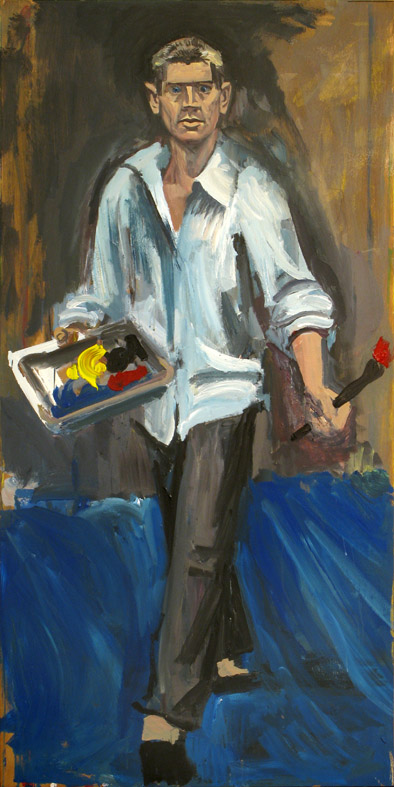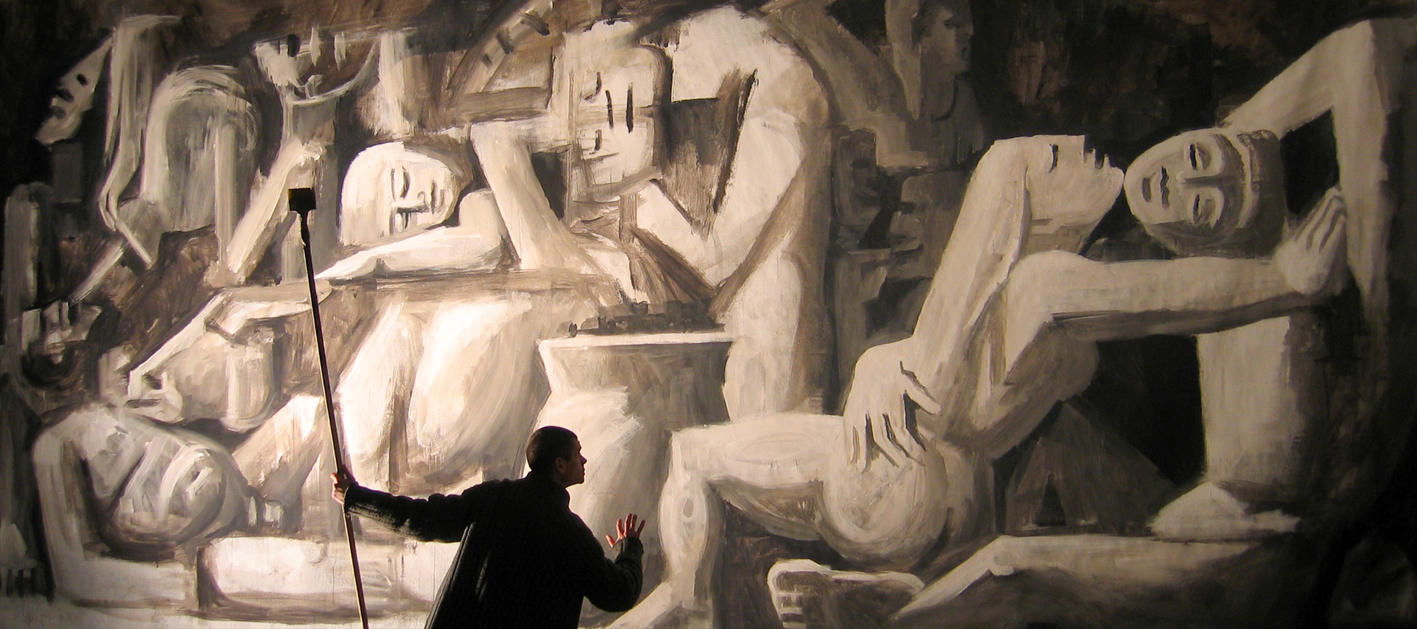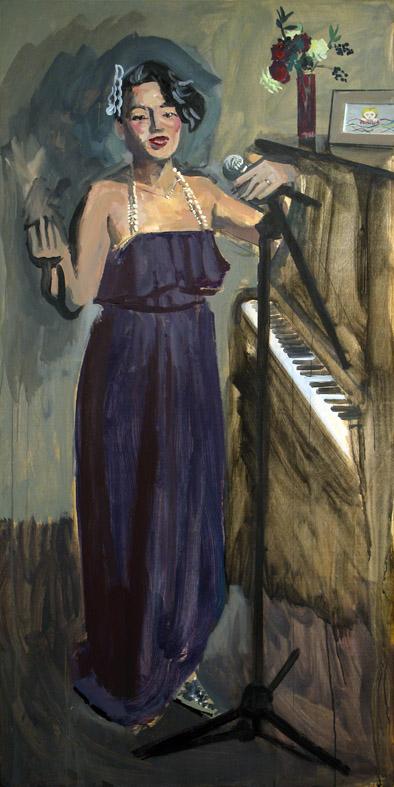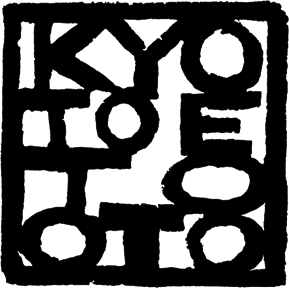Yann Le Gal
French, born in 1973; lives and works in Kyoto (Japan).

Born to a middle class family, he was eight years old when his father suddenly died. His mother raised him and played a formative role in his upbringing. The close bond formed between the two continues to influence his life and art.
During his apprenticeship, he witnessed the transformation of the école des beaux arts of Reims into a design art school, "ESAD", the transformation creating tensions and divisions between the old and new generations of teachers. To preserve independence as he worked towards achieving a level of artistic competence parallel with the great historic artists, Le Gal distanced himself from the noxious atmosphere of the school and the formulaic career promoted in this environment. This experience caused an overall rejection of the art-school curriculum, and his primary influences entail both classic and modern, from Rembrandt, to Rodin, Manet, Giacometti, and Picasso. Rather than the school taught rule, he incorporated elements that fall between classicism and expressionism, light and shadow, much of this acquired through his own research, into a uniquely introspective and fragile artistic language.
He was first recognised artistically in 1999 when he was awarded the Renoir Foundation prize. For one year, he resided and worked in the art residency at Essoyes (France, Aube), this residency being the former studio of the impressionist master. The work he produced at this time acquired a narcissistic theme, which caused him to recognise the existence of a time lag between the artist in their ivory tower and the local population. Essoyes is a small village located in the Champagne vineyards, the population primarily composed of agricultural workers whose awareness of art and the inherent theoretical problem is limited. This experience was a determining factor in the creation of the Kyoto portraits 100 project. Rather than the isolationist approach seen in the Essoyes period, Kyoto portraits 100 has adopted a confrontation approach in the Le Gal met the people living in the vicinity of his residence.
In 2007, Le Gal entered a new stage of development with the opening of his studio Box#104, a large store in the Reims suburbs. There, he faced the challenge of creating gigantic compositions. To acquire an understanding of vineyard culture, the symbol of the Champagne area, he pursued the theme of a bacchanal by drawing upon the original Greek myth of Dionysus. His studio transformed into a pagan temple decorated with two gigantic paintings, Oréibasie, a large canvas of 3.6 x 4 metres, which is an allegory of the birth of Dionysus, and The drunkenness of Silenus, a canvas of 3.6 x 8 metres sixty, which represents a gigantic and sculptural orgy.
During his apprenticeship, he witnessed the transformation of the école des beaux arts of Reims into a design art school, "ESAD", the transformation creating tensions and divisions between the old and new generations of teachers. To preserve independence as he worked towards achieving a level of artistic competence parallel with the great historic artists, Le Gal distanced himself from the noxious atmosphere of the school and the formulaic career promoted in this environment. This experience caused an overall rejection of the art-school curriculum, and his primary influences entail both classic and modern, from Rembrandt, to Rodin, Manet, Giacometti, and Picasso. Rather than the school taught rule, he incorporated elements that fall between classicism and expressionism, light and shadow, much of this acquired through his own research, into a uniquely introspective and fragile artistic language.
He was first recognised artistically in 1999 when he was awarded the Renoir Foundation prize. For one year, he resided and worked in the art residency at Essoyes (France, Aube), this residency being the former studio of the impressionist master. The work he produced at this time acquired a narcissistic theme, which caused him to recognise the existence of a time lag between the artist in their ivory tower and the local population. Essoyes is a small village located in the Champagne vineyards, the population primarily composed of agricultural workers whose awareness of art and the inherent theoretical problem is limited. This experience was a determining factor in the creation of the Kyoto portraits 100 project. Rather than the isolationist approach seen in the Essoyes period, Kyoto portraits 100 has adopted a confrontation approach in the Le Gal met the people living in the vicinity of his residence.
In 2007, Le Gal entered a new stage of development with the opening of his studio Box#104, a large store in the Reims suburbs. There, he faced the challenge of creating gigantic compositions. To acquire an understanding of vineyard culture, the symbol of the Champagne area, he pursued the theme of a bacchanal by drawing upon the original Greek myth of Dionysus. His studio transformed into a pagan temple decorated with two gigantic paintings, Oréibasie, a large canvas of 3.6 x 4 metres, which is an allegory of the birth of Dionysus, and The drunkenness of Silenus, a canvas of 3.6 x 8 metres sixty, which represents a gigantic and sculptural orgy.

The size and the style of these paintings clearly refer to Picasso, but Le Gal does more than merely quote the modern master. He revisits themes and iconographic codes of a subject that originate in Antiquity. He was working on a third painting, when the death of his mother put an end to its realisation. Ironically, whereas Box#104 was dedicated to gigantic paintings, the most poignant works of this time are small drawings done at the bedside of his mother in hospital.
Each step in Le Galʼs life and work can be understood as a rebirth that has allowed him to be increasingly open to the world, questioning the place he occupies, these experiences something he tries to express in his creations. Kyoto portraits 100 is another turning point that is the fruition of portrait studies completed over many years, opens the next cycle of development.
The essence of his art is primitive and instinctive: the works are quickly finished to preserve the sense of direct contact with the materials. This contrasts with the necessary process of reflection, which requires time, a slow maturation that allows him to implement his work over a long period. This current evolution permitted him to question his own practice, which in turn opened new ways of engaging in the dialectic between the myths of art history and contemporary society.
Each step in Le Galʼs life and work can be understood as a rebirth that has allowed him to be increasingly open to the world, questioning the place he occupies, these experiences something he tries to express in his creations. Kyoto portraits 100 is another turning point that is the fruition of portrait studies completed over many years, opens the next cycle of development.
The essence of his art is primitive and instinctive: the works are quickly finished to preserve the sense of direct contact with the materials. This contrasts with the necessary process of reflection, which requires time, a slow maturation that allows him to implement his work over a long period. This current evolution permitted him to question his own practice, which in turn opened new ways of engaging in the dialectic between the myths of art history and contemporary society.
Mayphy Miho Higashi
Japanese, born in 1972; lives and works in Kyoto, Japan

Mayphy is a multidisciplinary artist, dancer, musician, singer and composer. In the early 2000ʼs, she lived in Tokyo where she participated in the artistic underground, when she successively ran two theatrical productions, "Feelinʼ Soul 1" and "Feelinʼ Soul 2 Re incarnation". With this experience, she developed communication and management skills, which played a focal role in the successful completion of the Kyoto portraits 100 project.
After several years spent in dance and production activities, she decided to change her career to music and create something with an international dimension. From 2006 to 2010, she lived in London where she attended the vocal courses at Tech Music School and at "London Centre of Contemporary Music". This intense period of formation stimulated her creativity, as London is a vibrant city, a melting pot for the artistic community. She broadened her skills, and then turned to pop music, developed a jazz and world music repertoire. Her inexhaustible energy drew her to act in Griot, a musical at the Bernie Grand Art Center, directed by Amani Naphtari, the music produced by Drew Horley and Eska Mtungwazi. At the same time, she initiated another musical, "Bohemian Tour", produced by "Union Dance". She subsequently composed the music and libretto for Magic Carpet, one of her original texts, which became part of her working repertory. She graduated from the Associated Board of the Royal Schools of Music, which allowed her to teach piano and vocal for all ages. She then developed an original method of teaching based on communication skills, which gave her the idea of developing a complete universe of images and music through the creation of "Misolla", a character straddling pop culture and manga.
At the end of this rich London period, her meeting with Yann Le Gal took her to France. The wish for new experiences and new meetings brought about the creation a new song, Rebirth, which was inspired by the tragedy of the Earthquake and tsunami of 11 March 2011. She also collaborated with the French jazz and world music group, Phildissime, for an album recorded in Paris.
After several years spent in dance and production activities, she decided to change her career to music and create something with an international dimension. From 2006 to 2010, she lived in London where she attended the vocal courses at Tech Music School and at "London Centre of Contemporary Music". This intense period of formation stimulated her creativity, as London is a vibrant city, a melting pot for the artistic community. She broadened her skills, and then turned to pop music, developed a jazz and world music repertoire. Her inexhaustible energy drew her to act in Griot, a musical at the Bernie Grand Art Center, directed by Amani Naphtari, the music produced by Drew Horley and Eska Mtungwazi. At the same time, she initiated another musical, "Bohemian Tour", produced by "Union Dance". She subsequently composed the music and libretto for Magic Carpet, one of her original texts, which became part of her working repertory. She graduated from the Associated Board of the Royal Schools of Music, which allowed her to teach piano and vocal for all ages. She then developed an original method of teaching based on communication skills, which gave her the idea of developing a complete universe of images and music through the creation of "Misolla", a character straddling pop culture and manga.
At the end of this rich London period, her meeting with Yann Le Gal took her to France. The wish for new experiences and new meetings brought about the creation a new song, Rebirth, which was inspired by the tragedy of the Earthquake and tsunami of 11 March 2011. She also collaborated with the French jazz and world music group, Phildissime, for an album recorded in Paris.
Kyo to e to oto

The meeting between Mayphy and Yann Le Gal led them to a first collaboration for an open day at his studio in Reims. For this occasion, they performed a mixture of live painting and dance on the bacchanal theme. They performed again for an experimental video in which the painter, acting the role of a satyr chasing a nymph, is metaphorically pursuing his subject for painting.
In 2012, they settled in Kyoto, where they established their studio Kyo to e to oto “Today, art, and music”, to develop new artistic projects.
"Kyo to e to oto" is a space in which they create artworks, and organise events, concerts and live painting, to build a fabric of social relationships. Also, it is an entity that lets them to be involved in various public events in the Kansai area, such as fête de la musique, the Osaka France Fair, charity concerts, and more.
The implementation of the Kyoto portraits 100 project marks the completion of one collaborative work, and in 2014, Kyo to e to oto became a publisher in order to spread this experience.
In 2012, they settled in Kyoto, where they established their studio Kyo to e to oto “Today, art, and music”, to develop new artistic projects.
"Kyo to e to oto" is a space in which they create artworks, and organise events, concerts and live painting, to build a fabric of social relationships. Also, it is an entity that lets them to be involved in various public events in the Kansai area, such as fête de la musique, the Osaka France Fair, charity concerts, and more.
The implementation of the Kyoto portraits 100 project marks the completion of one collaborative work, and in 2014, Kyo to e to oto became a publisher in order to spread this experience.
© Kyo to e to oto & Yann Le Gal 2017 - All right reserved - Web Developer: P. Baillehache
